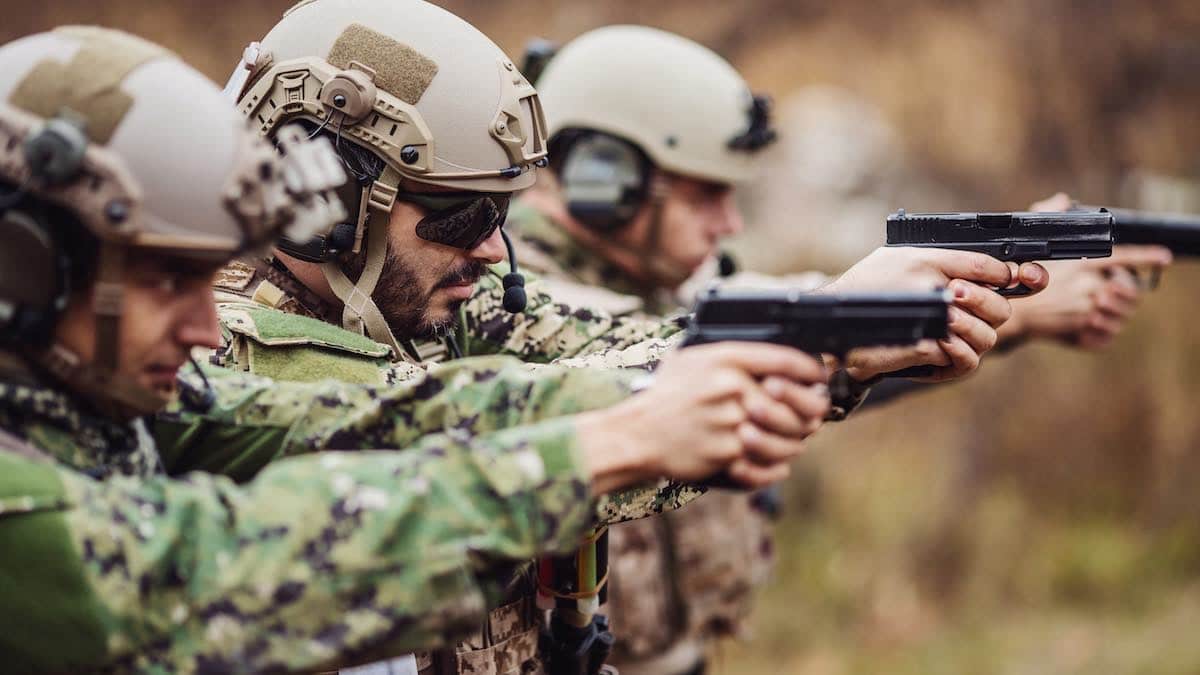With IM you can easily scale & grow your practice, all while achieving better patient outcomes!

Interactive Metronome Improves Fine-Motor Control in Study with Trained Military Marksman
Published In "Perceptual And Motor Skills"

Keywords
Adult, Cognitive Skills, Military Readiness, Motor Skills
Harnessing Interactive Metronome Training to Boost Military Weapon Firing Precision
In a 2020 study published in ‘Perceptual and Motor Skills’, researchers investigated the impact of Interactive Metronome (IM) training on weapon firing precision among active duty U.S. Army service members with prior marksmanship experience.
The study involved a group of 41 service members, randomly divided into an experimental group (18 members with a mean age of 31) that received 12 sessions of IM training, and a control group (23 members with a mean age of 26) that did not receive any IM training. They were tested using a weapon firing simulator to hit random stationary and moving targets up to 300m distance.
Different measures were used to evaluate precision and accuracy of the firing, including shot group distance from the center of mass (COM), individual shot distance from COM, mean radius (MR), height and width (H+W) of the shot group, and total path length (TPL), which represents the sum of distances between each consecutive shot location.
Results showed that the service members who underwent IM training displayed a significant reduction in variability and improvement in precision when firing at a 175m target compared to the control group. This finding highlights the promising effects of neurocognitive temporal training through IM on weapon firing precision, potentially enhancing the performance and safety of military operations.
In summary, this study provides compelling evidence that Interactive Metronome training can significantly enhance weapon firing precision in active military personnel, thus making it a valuable addition to training regimes in the military.
Abridged Summary & Results of Study
Effects of Neurocognitive Temporal Training on Weapon Firing Performance by Leah R. Enders, Gary L. Boykin, and Valerie J. Rice
Published in PERCEPTUAL AND MOTOR SKILLS
YEAR: 2020
RESULTS:
Active duty U.S. Army service members with prior marksmanship experience that received Interactive Metronome (IM) training demonstrated significantly reduced variability and improved precision when firing at a 175m target when compared to matched controls. This study revealed a promising neurocognitive temporal training effect on weapon firing precision.
DETAILS:
Subjects were randomly assigned to:
- Â Experimental group: n=18 (mean age = 31) active duty service members received 12 sessions of IM training
- Control group: n=23 (mean age = 26) active duty service members that did not receive IM training
OUTCOME MEASURES
- Weapon firing using a weapon firing simulator, the Engagement Skills Trainer 2000 using a mock M16A4 without laser assist to hit random order stationary and moving targets up to 300m distance.
- TPL: total path length (a precision measure to capture shot-to-shot realignment, a critical component of repeated firing)
- Â Accuracy is a measure of how close the shot came to hitting the COM (center of mass (a 4-cm zone in the center of the targets, also known as the lethal zone)
- Total Hit Point score captured how well participants fired a shot in the designated lethal (COM) versus nonlethal zones.
- Shot Group Distance from Center of Mass (DCMSG): the distance between the center of the shot group and the COM, representing the average error of a participant’s shot group
- Individual Shot Distance from Center of Mass (DCMS): the average distance between the individual shots of the shot group and the COM, representing the individual error of each shot fired
- Precision is a measure of shot reproducibility or variability and is defined as how consistent or tight the shot group was in terms of location on the target (as an example, previous IM studies on the sport of golf have shown increased precision and decreased variability of the golf shot following IM training with golfers consistently hitting the ball closer to the pin)
- Mean Radius (MR): overall mean distance of all shots and the center of the shot group or radial spread of the shot group (least sensitive to aberrant shots)
- Height and width (H+W): sum of the horizontal range and vertical range of the shots on the target, indicating the horizontal and vertical spread of shot group
- Total Path Length (TPL): sum of distances between each consecutive shot location (most sensitive to aberrant shots, measures variability or the ability to hit the same location on a shot-to-shot basis)
Get IM Certified!
Getting Certified in Interactive Metronome is Easy! Attend a Live, Online Virtual Certification course and in one day you can start offering Interactive Metronome to your clients.
Education, Support & More!
We offer ongoing support and continuing education in Interactive Metronome so you can get the most from it. Learn how to profitably implement IM into your practice and help more patients in less time.
Our FREE on-demand library is chock full of specific short classes tailored to different populations and conditions as well as advanced IM application courses.
We routinely have Live webinars where you can sharpen your skills and learn the latest from clinicians.
And our clinical advisers are happy to help you with suggestions for particular clients.





